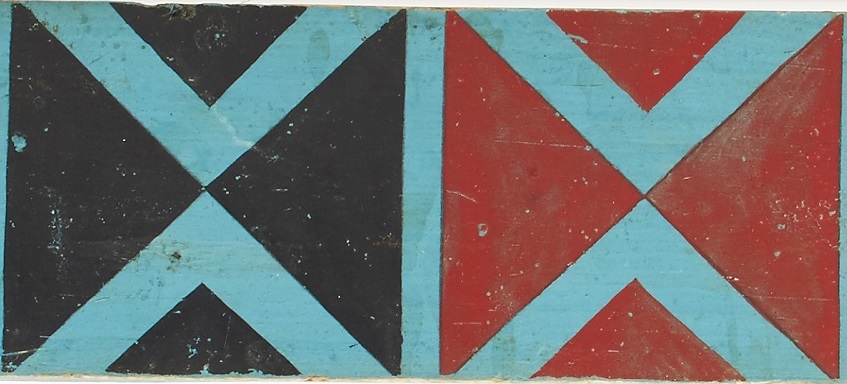Practical, utilitarian, sometimes with a jazzy decorative appeal these items were considered a relevant part of gift exchange at marriage ceremonies in Kwa Zulu Natal, last century.
Mat holders, ibhaxa, (amabhaxa for plural) are made by the Zulu people. These rectangular frames are generally 50-80 cm in height, consisting of pairs of vertically placed planks sometimes attached at the top and bottom by pieces of wood for strength. Generally of a rickety appearance, the structure is secured together with nails, gathering weight and stability only when filled with rolled up grass mats.
Grass mats (icansi) are made in different dimensions and laid on the floor for sleeping or sitting on. When not in use, mats were rolled, inserted horizontally into the holder and hung on walls of Zulu abodes, out of the way of snakes seeking shade on a hot day. Households generally procured a set of two wooden frames of assorted sizes as the ideal storage solution.
Mat holders were made by craftsmen selling their wares to members of the local community. The flat plank like frames were the ideal surface for feats of creative expression and the artists’ unique vision. The motifs, subject matter and style of these items also varied across geographical regions according to local and tribal preference. Obviously competition compelled craftsmen to produce the most engaging result thereby increasing the commercial demand for their particular work.
The sometimes outrageous decoration of these mat holders, developed into a popular art form that was dynamic, inventive and changed over time. The inspiration used for decorating these frames originated from various sources. Some were traditional, for example: The use of repetitive geometric motifs such as triangular or diamond shapes was taken from traditional beadwork and reinvented on the surfaces of mat holders into recurrent blocks of patterning that acted in visually unifying the piece. The use of these motifs was a visual reinforcement of cultural heritage, of the language of beads and its social significance in their daily lives.
Other inspiration was drawn from popular culture. An example was the symbols from the packs of playing cards, or from the same advertising decals responsible for the visual development of the Zulu ear plugs in the 1950’s. One can further speculate that the architectural details prevalent on art deco buildings in Durban and Johannesburg resulted in the manipulation of these particular motifs by migrant workers in the residential sector, into a traditional craft format.
 Techniques both old and new were employed to embellish mat holders. The use of colour with powder or enamel paint sometimes with resist areas, created fabulous abstract geometric patterns.
Techniques both old and new were employed to embellish mat holders. The use of colour with powder or enamel paint sometimes with resist areas, created fabulous abstract geometric patterns.
Traditional methods previously reserved for decorating headrests, for example low relief carving with pokerwork, were skills particularly well suited for crafting designs or making figurative images. Carved in the round on stick finials, figurative images were reinterpreted here into flat portraits on the upright struts of mat holders.
Most mat holders are unsigned and therefore anonymous. However some are identified by the unique forceful character of their work, for instance that of the Quabe brothers, Nongoma area. Their depictions of low relief figures and wild and domestic animals were compartmentalized into small vignettes of village life, forming a vertically read narrative displayed in a humble, seemingly naïve way but sometimes with a biting socio-political commentary.

A diverse range of products made between the 1940s-1960s mirrored each other in style and inventiveness.
The motifs, colours and symbolism reflected the development of a popular Zulu culture bolstered by the experiences and occupations of migrant workers. The additional use of materials such as paint, vinyl, marley tiles, bicycle reflectors, brass studs resulted in a new appreciation for shiny surfaces and bright colours that enhanced their beadwork, traditional costume and furniture. Material accoutrements such as mat holders, earplugs, wire covered sticks, bottles and tire sandals to name a few, forged a new identity and character for the Zulu migrant worker, and was distinctive.
Today these decorative items add impetus to a vibrant discourse on the visual history of the Zulu people.

This geometric mat holder example is from the 1950s.

Today, matholders are highly collectable and they are still made and used in the rural areas.
If you enjoy this blog, please share it with other enthusiasts.
© Copyright





Leave a comment